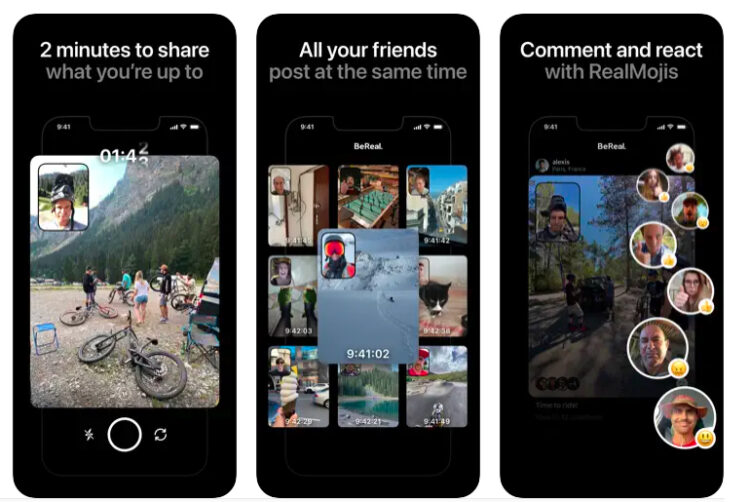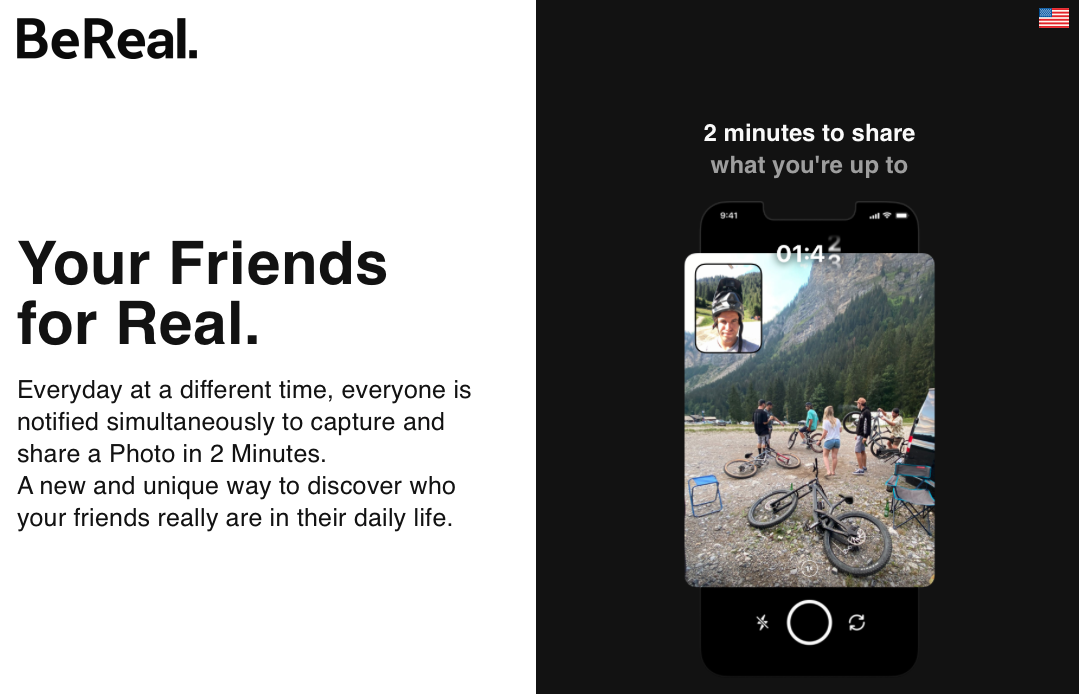BeReal: the latest fad or the next big thing?

At a random time each day, increasing numbers of young users are being told it is “time to BeReal”.
The social media app, founded by French app designer and former GoPro employee Alexis Barreyat, debuted in 2020 and has seen ascendant popularity among young users this summer who have propelled it to the top of the app store charts—ahead of other social media darlings TikTok and Instagram—since 18 July.
The long-tailed rise of BeReal is unique in an era of social media that saw other apps, such as Clubhouse, reach immediate success during the pandemic. The company received $30m in seed funding from Andreessen Horowitz‘s consumer investor Andrew Chan in the summer of 2021 (Andreessen Horowitz was also a key early funder of Clubhouse). But the appeal of BeReal has only increased as individuals emerge from pandemic restrictions into (relatively) more exciting lives.
The number of BeReal downloads, which eclipsed 29.5 million last week according to The Verge, has signaled a rapid increase in interest this year.
Ironically, its spread has been helped by competitor social media companies, with memes inspired by BeReal’s now-iconic notification garnering high engagement on TikTok and Twitter.
The app encourages its users to share honest, candid, and unedited photos of themselves and what they are doing in a given moment during the day, as opposed to the more curated posts seen on Instagram or the overwhelming competition to stand out on TikTok.
BeReal instead wants, well, B-reel footage from your life.
The app, which is receiving extensive buzz around tech and adland, works by giving users two minutes to post front and back-facing pictures of what they are doing in the given moment. Users can still post after the two minutes are up, but they won’t be able to see their friends’ posts until they do.
The quirk incentivizes authenticity, especially as the app tracks how many times a user has retaken a photo before posting. For many, BeReal marks a return to the early days of social media, when “poking” friends was an hourly task and Google was still testing Hangouts. In more recent years, social media platforms have lost hard-earned good will after sentiments of inauthentic online behavior have taken root.

“BeReal is following a near two-decade old, tried-and-tested playbook for building scale on new social media platforms: make creative constraint a feature—here the constraint is the short time-frame users have to post,” says Scott Guthrie, board member of the Influencer Marketing Trade Body.
Guthrie adds that BeReal is rightly focusing on teens and early twentysomethings while remaining ad-free as it scales, generates hype, increases reach, and maintains a ‘cool’ factor.
As TikTok and Meta battle it out to see which social media platforms can recommend the most (ad-sponsored) content to users in a bid to draw as many eyeballs and usage hours as possible, BeReal is filling the authenticity void they are leaving through quick, in-and-out daily content. The best social media app is one that users don’t have to spend hours of time in, BeReal appears to suggest, while not overwhelming consumers with sponsored content.
Lola Randles, brand partnerships manager at Fanbytes by Brainlabs, notes: “There’s a lot of competition out there, but the photo-sharing app seems to have cracked the ‘right place, right time’ code, in terms of surfacing during a period where younger generations have never been more digitally connected, and desperate for authenticity and realism from and amongst their peers.”
Other features of the app include the ability to see memories of your posts in a calendar-based user interface, the ability to send “Realmojis”—selfies of your reaction to friends’ posts, and a map of where you and your friends are posting from akin to Snapchat’s Snap Map.
‘BeReal can’t build a robust business around an egg timer’
The app’s most important contrivance — time compression — could also be its biggest weakness, says Guthrie.
“BeReal limits performative posting by reducing time to set-up the photo to 120 seconds. Time compression might well work against the app in terms of the adoption curve, however. Apps like Mastodon, Ello, Vero, and Clubhouse all flamed brightly but the glow was short lived. BeReal can’t build a robust business around an egg timer. To survive it’ll need to listen carefully to its users and roll out enhanced features to meet their fickle needs.”
Alternatively, it would surprise no one if established social media platforms like TikTok, Instagram, and Snapchat (despite its dire financial straits) sought to copy the BeReal model and incorporate time constraints and the use of both the front and back camera at the same time into their own applications. In other words, BeReal’s moat, if it currently has one, may be easily taken on by competitors, as Facebook and Instagram have been known to do.
This is especially true as BeReal currently struggles with bugs. According to Guthrie, this is due in part to the nature of everyone in a region posting at the same time during the day and seldom using the app otherwise.
“The pressure on its systems must be tantamount to a stiletto heel bearing down on a balloon. The app is suffering as a consequence.”
He notes that in May, over half (56.4%) of all reviews of the app mentioned “negative“ or “mixed” performance and “bugs” according to Apptopia.
Randles adds: “If it can crack down on its bugs and glitches, and remain true to its foundations, then the future could be bright for the platform.”
‘Brands should tread carefully’
Currently, BeReal doesn’t offer much in the opportunity for brands or advertisers. The app has two main areas through which to explore content—from your friends, as well as a Discovery page that shares random strangers’ pictures from around the world. Users can opt-in to posting on the Discovery page.
Like with Snapchat, Discovery could potentially lead to opportunities for branded content or the expansion of creators on the platform, should the company seek monetization.
“You could say monetization is inevitable,” says Randles, adding: “however, it could be that the app will diverge from the more outdated avenues of making money, such as running display ads, and will likely focus more on establishing long term partnerships with brands who reflect similar values and ethoses to the app itself, the likes of Monki or Dove”.
At the moment, though, users are pretty much just employing the app to keep up with close friends as they share mundane images typically at work or lounging around at home.
“There may be an opportunity for brands to scale employee advocacy with the app. But brands should tread carefully,” warns Guthrie.
“BeReal is built on the premise of authenticity, of sharing images of the unvarnished you. Uploaded shots from brands and their employees should feel natural and unforced. Any gap between what the brand says it does and what it really does will get blown up negatively on social media.”
BeReal’s appeal is that it doesn’t feel fake or dishonest, a novelty among social media platforms. Advertisements, on the contrary, can come across as ingenuine—ultimately what a digital ad is after, be it posted through a creator or from a business itself, is your money, not a fun sense of community and socialization.
But that doesn’t mean brands shouldn’t cautiously consider using BeReal to promote content, says Guthrie.
“If the brand ‘walks its talk’, however, there could be considerable upside. Companies willing to share behind-the-scenes content will play well here. Brands sufficiently trusting to allow their employees to share candid snapshots of the processes and the culture driving their brands will stand out.”
Randles adds that the unique makeup of the app, with only one short, unpredictably timed chance to post during the day, could both create interesting constraints on creative and “initiate inspiring impulse purchases amongst its users” that could be timed with sales: “think Black Friday, but a much smaller window!”
Whether BeReal will burn out as quickly as it has come to prominence is unknown. For many, taking and viewing pictures of the banal moments in life can be a fun novelty at first, but wear out its welcome quickly. For others, there appears to be genuine staying power in checking in with friends and the satisfaction in building a visual diary of images to look back on throughout the year.
And, while not yet a mature playground for marketing, the potential to reach young people is always likely to draw a crowd.




